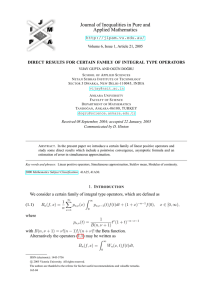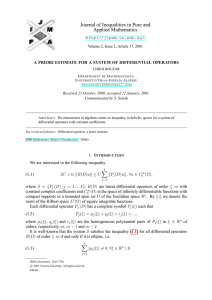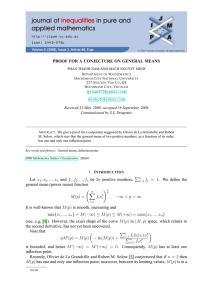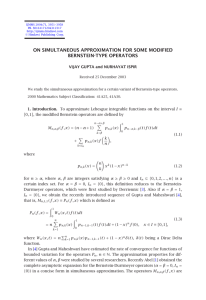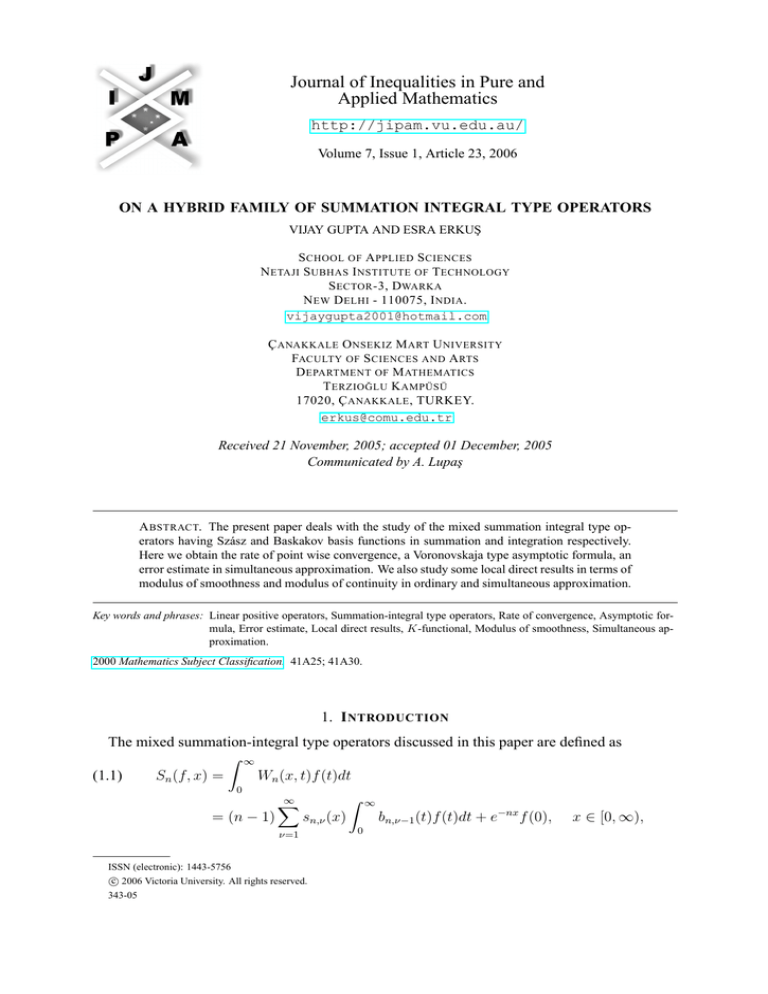
Journal of Inequalities in Pure and
Applied Mathematics
http://jipam.vu.edu.au/
Volume 7, Issue 1, Article 23, 2006
ON A HYBRID FAMILY OF SUMMATION INTEGRAL TYPE OPERATORS
VIJAY GUPTA AND ESRA ERKUŞ
S CHOOL OF A PPLIED S CIENCES
N ETAJI S UBHAS I NSTITUTE OF T ECHNOLOGY
S ECTOR -3, DWARKA
N EW D ELHI - 110075, I NDIA .
vijaygupta2001@hotmail.com
Ç ANAKKALE O NSEKIZ M ART U NIVERSITY
FACULTY OF S CIENCES AND A RTS
D EPARTMENT OF M ATHEMATICS
T ERZIO ĞLU K AMPÜSÜ
17020, Ç ANAKKALE , TURKEY.
erkus@comu.edu.tr
Received 21 November, 2005; accepted 01 December, 2005
Communicated by A. Lupaş
A BSTRACT. The present paper deals with the study of the mixed summation integral type operators having Szász and Baskakov basis functions in summation and integration respectively.
Here we obtain the rate of point wise convergence, a Voronovskaja type asymptotic formula, an
error estimate in simultaneous approximation. We also study some local direct results in terms of
modulus of smoothness and modulus of continuity in ordinary and simultaneous approximation.
Key words and phrases: Linear positive operators, Summation-integral type operators, Rate of convergence, Asymptotic formula, Error estimate, Local direct results, K-functional, Modulus of smoothness, Simultaneous approximation.
2000 Mathematics Subject Classification. 41A25; 41A30.
1. I NTRODUCTION
The mixed summation-integral type operators discussed in this paper are defined as
Z ∞
(1.1)
Sn (f, x) =
Wn (x, t)f (t)dt
0
= (n − 1)
∞
X
Z
sn,ν (x)
ν=1
ISSN (electronic): 1443-5756
c 2006 Victoria University. All rights reserved.
343-05
0
∞
bn,ν−1 (t)f (t)dt + e−nx f (0),
x ∈ [0, ∞),
2
V IJAY G UPTA
where
Wn (x, t) = (n − 1)
∞
X
AND
E SRA E RKU Ş
sn,ν (x)bn,ν−1 (t) + e−nx δ(t),
ν=1
δ(t) being Dirac delta function,
(nx)ν
ν!
and
n+ν−1 ν
bn,ν (t) =
t (1 + t)−n−ν
ν
are respectively Szász and Baskakov basis functions. It is easily verified that the operators (1.1)
are linear positive operators, these operators were recently proposed by Gupta and Gupta in [3].
The behavior of these operators is very similar to the operators studied by Gupta and Srivastava
[5], but the approximation properties of the operators Sn are different in comparison to the
operators studied in [5]. The main difference is that the operators (1.1) are discretely defined
at the point zero. Recently Srivastava and Gupta [8] proposed a general family of summationintegral type operators Gn,c (f, x) which include some well known operators (see e.g. [4], [7])
as special cases. The rate of convergence for bounded variation functions was estimated in
[8], Ispir and Yuksel [6] considered the Bézier variant of the operators Gn,c (f, x) and studied
the rate of convergence for bounded variation functions. We also note here that the results
analogous to [6] and [8] cannot be obtained for the mixed operators Sn (f, x) because it is not
easier to write the integration of Baskakov basis functions in the summation form of Szász basis
functions, which is necessary in the analysis for obtaining the rate of convergence at the point
of discontinuity. We propose this as an open problem for the readers.
In the present paper we study some direct results, for the class of unbounded functions with
growth of order tγ , γ > 0, for the operators Sn we obtain a point wise rate of convergence,
asymptotic formula of Voronovskaja type, and an error estimate in simultaneous approximation. We also estimate local direct results in terms of modulus of smoothness and modulus of
continuity in ordinary and simultaneous approximation.
sn,ν (x) = e−nx
2. AUXILIARY R ESULTS
We will subsequently need the following lemmas:
Lemma 2.1. For m ∈ N0 = N ∪ {0}, if the m-th order moment is defined as
∞
ν
m
X
sn,ν (x)
−x ,
Un,m (x) =
n
ν=0
then Un,0 (x) = 1, Un,1 (x) = 0 and
(1)
nUn,m+1 (x) = x Un,m
(x) + mUn,m−1 (x) .
Consequently
Un,m (x) = O n−[(m+1)/2] .
Lemma 2.2. Let the function µn,m (x), m ∈ N0 , be defined as
Z ∞
∞
X
µn,m (x) = (n − 1)
sn,ν (x)
bn,ν−1 (t)(t − x)m dt + (−x)m e−nx .
ν=1
0
Then
µn,0 (x) = 1,
µn,1 (x) =
J. Inequal. Pure and Appl. Math., 7(1) Art. 23, 2006
2x
,
n−2
µn,2 (x) =
nx(x + 2) + 6x2
,
(n − 2)(n − 3)
http://jipam.vu.edu.au/
O N A H YBRID FAMILY
OF
S UMMATION I NTEGRAL T YPE O PERATORS
3
also we have the recurrence relation:
(n − m − 2)µn,m+1 (x) = x µ(1)
n,m (x) + m(x + 2)µn,m−1 (x)
+ [m + 2x(m + 1)] µn,m (x);
n > m + 2.
Consequently for each x ∈ [0, ∞) we have from this recurrence relation that
µn,m (x) = O n−[(m+1)/2] .
Remark 2.3. It is easily verified from Lemma 2.2 that for each x ∈ (0, ∞)
(2.1)
Sn (ti , x) =
(n − i − 2)!
(n − i − 2)!
(nx)i + i(i − 1)
(nx)i−1 + O(n−2 ).
(n − 2)!
(n − 2)!
Lemma 2.4. [5]. There exist the polynomials Qi,j,r (x) independent of n and ν such that
X
ni (ν − nx)j Qi,j,r (x)sn,ν (x),
xr Dr [sn,ν (x)] =
2i+j≤r
i,j≥0
where D ≡
d
.
dx
Lemma 2.5. Let n > r ≥ 1 and f (i) ∈ CB [0, ∞) for i ∈ {0, 1, 2, . . . , r} (cf. Section 3). Then
Z ∞
∞
X
nr
(r)
Sn (f, x) =
sn,ν (x)
bn−r,ν+r−1 (t)f (r) (t)dt.
(n − 2) · · · (n − r − 1) ν=0
0
3. D IRECT R ESULTS
In this section we consider the class Cγ [0, ∞) of continuous unbounded functions, defined as
f ∈ Cγ [0, ∞) ≡ {f ∈ C[0, ∞) : |f (t)| ≤ M tγ , for some M > 0, γ > 0} .
We prove the following direct estimates:
Theorem 3.1. Let f ∈ Cγ [0, ∞), γ > 0 and f (r) exists at a point x ∈ (0, ∞), then
lim Sn(r) (f (t), x) = f (r) (x).
(3.1)
n→∞
Proof. By Taylor’s expansion of f , we have
f (t) =
r
X
f (i) (x)
i=0
i!
(t − x)i + ε(t, x)(t − x)r ,
where ε(t, x) → 0 as t → x. Thus, using the above, we have
Z ∞
(r)
Sn (f, x) =
Wn(r) (t, x)f (t)dt
0
=
Z
r
X
f (i) (x)
i=0
i!
= R1 + R2 ,
∞
Wn(r) (t, x)(t
0
i
Z
− x) dt +
∞
Wn(r) (t, x)ε(t, x)(t − x)r dt
0
say.
J. Inequal. Pure and Appl. Math., 7(1) Art. 23, 2006
http://jipam.vu.edu.au/
4
V IJAY G UPTA
AND
E SRA E RKU Ş
First to estimate R1 , using a binomial expansion of (t − x)m and applying (2.1), we have
r
i r Z ∞
X
f (i) (x) X i
i−ν ∂
R1 =
(−x)
Wn (t, x)tν dt
r
i!
ν
∂x
0
ν=0
i=0
r
(r)
(n − r − 2)!nr r
f (x) d
=
x + terms containing lower powers of x
r! dxr
(n − 2)!
(n − r − 2)!nr
(r)
= f (x)
→ f (r) (x) as n → ∞.
(n − 2)!
Next using Lemma 2.4, we obtain
X |Qi,j,r (x)|
ni
|R2 | ≤ (n − 1)
xr
2i+j≤r
i,j≥0
∞
X
×
∞
Z
j
bn,ν−1 (t) |ε(t, x)| (t − x)r dt
|ν − nx| sn,ν (x)
0
ν=1
+ (−n)r e−nx |ε(0, x)| (−x)r
= R3 + R4 , say.
Since ε(t, x) → 0 as t → x for a given ε > 0 there exists a δ > 0 such that |ε(t, x)| < ε
whenever 0 < |t − x| < δ. Further if s ≥ max {γ, r}, where s is any integer, then we can find
a constant M1 > 0 such that |ε(t, x)(t − x)r | ≤ M1 |t − x|s , for |t − x| ≥ δ. Thus
∞
X
X
R3 ≤ M2 (n − 1)
ni
sn,ν (x)
ν=1
2i+j≤r
i,j≥0
Z
× |ν − nx| ε
j
bn,ν−1 (t)M1 |t − x| dt
Z
r
s
bn,ν−1 (t) |t − x| dt +
|t−x|<δ
|t−x|≥δ
= R5 + R6 ,
say.
Applying the Schwarz inequality for integration and summation respectively, and using Lemma
2.1 and Lemma 2.2, we obtain
∞
X
X
i
R5 ≤ εM2 (n − 1)
n
sn,ν (x)
ν=1
2i+j≤r
i,j≥0
j
∞
Z
× |ν − nx|
12 Z
bn,ν−1 (t)dt
X
2i+j≤r
ni
∞
X
12
bn,ν−1 (t)(t − x) dt
2r
0
0
≤ εM2
∞
! 21
sn,ν (x)(ν − nx)2j
ν=1
i,j≥0
×
(n − 1)
∞
X
≤ εM2
ni O n
j/2
bn,ν−1 (t)(t − x)2r dt
sn,ν (x)
0
ν=1
X
O n
! 21
∞
Z
−r/2
= εO(1).
2i+j≤r
i,j≥0
J. Inequal. Pure and Appl. Math., 7(1) Art. 23, 2006
http://jipam.vu.edu.au/
O N A H YBRID FAMILY
OF
S UMMATION I NTEGRAL T YPE O PERATORS
5
Again using the Schwarz inequality, Lemma 2.1 and Lemma 2.2, we get
X
R6 ≤ M3 (n − 1)
n
i
∞
X
j
sn,ν (x) |ν − nx|
bn,ν−1 (t) |t − x|s dt
|t−x|≥δ
ν=1
2i+j≤r
Z
i,j≥0
X
≤ M3
! 12
∞
X
ni
sn,ν (x)(ν − nx)2j
ν=1
2i+j≤r
i,j≥0
×
(n − 1)
∞
X
Z
=
ni O n
j/2
O n
bn,ν−1 (t)(t − x)2s dt
sn,ν (x)
0
ν=1
X
! 12
∞
−s/2
= O n(r−s)/2 = o(1).
2i+j≤r
i,j≥0
Thus due to the arbitrariness of ε > 0 it follows that R3 = o(1). Also R4 → 0 as n → ∞ and
therefore R2 = o(1). Collecting the estimates of R1 and R2 , we get (3.1).
Theorem 3.2. Let f ∈ Cγ [0, ∞), γ > 0. If f (r+2) exists at a point x ∈ (0, ∞), then
lim n Sn(r) (f, x) − f (r) (x)
n→∞
=
r(r + 3) (r)
x
f (x) + [x(2 + r) + r] f (r+1) (x) + (2 + x)f (r+2) (x).
2
2
Proof. By Taylor’s expansion of f , we have
f (t) =
r+2 (i)
X
f (x)
i=0
i!
(t − x)i + ε(t, x)(t − x)r+2
where ε(t, x) → 0 as t → x. Applying Lemma 2.2 and the above Taylor’s expansion, we have
" r+2
#
X f (i) (x) Z ∞
(r)
n Sn (f (t), x) − f (r) (x) = n
Wn(r) (t, x)(t − x)i dt − f (r) (x)
i!
0
i=0
Z ∞
(r)
r+2
+ n
Wn (t, x)ε(t, x)(t − x) dt
0
= E1 + E2 , say.
E1 = n
r+2 (i)
i X
f (x) X i
i=0
=
i!
j=0
j
i−j
Z
(−x)
∞
Wn(r) (t, x)tj dt − nf (r) (x)
0
f (r+1) (x) f (r) (x) (r) r
n Sn (t , x) − r! +
n (r + 1)(−x)Sn(r) (tr , x) + Sn(r) (tr+1 , x)
r!
(r + 1)!
f (r+2) (x) (r + 2)(r + 1) 2 (r) r
(r) r+1
(r) r+2
+
n
x Sn (t , x) + (r + 2)(−x)Sn (t , x) + Sn (t , x) .
(r + 2)!
2
J. Inequal. Pure and Appl. Math., 7(1) Art. 23, 2006
http://jipam.vu.edu.au/
6
V IJAY G UPTA
AND
E SRA E RKU Ş
Therefore, using (2.1) we have
E1 = nf
(r)
nr (n − r − 2)!
−1
(x)
(n − 2)!
r
f (r+1) (x)
n (n − r − 2)!
(r + 1)(−x)r!
+n
(r + 1)!
(n − 2)!
r+1
n (n − r − 3)!
nr (n − r − 3)!
+
(r + 1)!x + r(r + 1)
r!
(n − 2)!
(n − 2)!
f (r+2) (x) (r + 2)(r + 1)x2
nr (n − r − 2)!
+
(r!)
(r + 2)!
2
(n − 2)!
r+1
n (n − r − 3)!
nr (n − r − 3)!
(r + 1)!x + r(r + 1)
r!
+ (r + 2)(−x)
(n − 2)!
(n − 2)!
r+2
n (n − r − 4)! (r + 2)! 2
x
+
(n − 2)!
2
nr+1 (n − r − 4)!
−2
+(r + 1)(r + 2)
(r + 1)!x + O n
.
(n − 2)!
In order to complete the proof of the theorem it is sufficient to show that E2 → 0 as n → ∞,
which can easily be proved along the lines of the proof of Theorem 3.1 and by using Lemma
2.1, Lemma 2.2 and Lemma 2.4.
Theorem 3.3. Let f ∈ Cγ [0, ∞), γ > 0 and r ≤ m ≤ r + 2. If f (m) exists and is continuous
on (a − η, b + η) ⊂ (0, ∞), η > 0, then for n sufficiently large
m
X
(r)
(i) Sn (f, x) − f (r) ≤ M4 n−1
f + M5 n−1/2 w f (r+1) , n−1/2 + O n−2 ,
i=1
where the constants M4 and M5 are independent of f and n, w(f, δ) is the modulus of continuity
of f on (a − η, b + η) and k·k denotes the sup-norm on the interval [a, b] .
Proof. By Taylor’s expansion of f , we have
f (t) =
m
X
(t − x)i
i=0
f (i) (x)
f m (ξ) − f m (x)
+ (t − x)m ζ(t)
+ h(t, x) (1 − ζ(t)) ,
i!
m!
where ζ lies between t and x and ζ(t) is the characteristic function on the interval (a − η, b + η).
For t ∈ (a − η, b + η), x ∈ [a, b] , we have
f (t) =
m
X
(t − x)i
i=0
f (i) (x)
f m (ξ) − f m (x)
+ (t − x)m
.
i!
m!
For t ∈ [0, ∞) \ (a − η, b + η), x ∈ [a, b] , we define
h(t, x) = f (t) −
m
X
i=0
J. Inequal. Pure and Appl. Math., 7(1) Art. 23, 2006
(t − x)i
f (i) (x)
.
i!
http://jipam.vu.edu.au/
O N A H YBRID FAMILY
S UMMATION I NTEGRAL T YPE O PERATORS
OF
7
Thus
Sn(r) (f, x) − f (r) (x) =
( m
X f (i) (x) Z
)
∞
Wn(r) (t, x)(t − x)i dt − f (r) (x)
i!
0
Z ∞
f m (ξ) − f m (x)
(r)
m
+
Wn (t, x)
(t − x) ζ(t)dt
m!
0
Z ∞
(r)
+
Wn (t, x)h(t, x)(1 − ζ(t))dt
i=0
0
= ∆1 + ∆2 + ∆3 ,
say.
Using (3.1), we obtain
∆1 =
m
i X
f (i) (x) X i
i!
i=0
=
j
j=0
i−j
(−x)
m
i X
f (i) (x) X i
∂r
∂xr
Z
∞
Wn (t, x)tj dt − f (r) (x)
0
∂ r (n − j − 2)!
(−x)
(nx)j
i! j=0 j
∂xr
(n − 2)!
(n − j − 2)!
j−1
−2
+j(j − 1)
(nx) + O n
− f (r) (x).
(n − 2)!
i=0
i−j
Hence
k∆1 k ≤ M4 n
−1
m
X
(i) f + O n−2 ,
i=r
uniformly in x ∈ [a, b]. Next
∞
m
(r)
m
Wn (t, x) |f (ξ) − f (x)| |t − x|m ζ(t)dt
m!
0
Z ∞
(m)
(r)
w f ,δ
|t
−
x|
Wn (t, x) 1 +
≤
|t − x|m dt.
m!
δ
0
Z
|∆2 | ≤
Next, we shall show that for q = 0, 1, 2, ...
(n − 1)
∞
X
j
Z
∞
sn,ν (x) |ν − nx|
bn,ν−1 (t) |t − x|q dt = O n(j−q)/2 .
0
ν=1
Now by using Lemma 2.1 and Lemma 2.2, we have
(n − 1)
∞
X
j
Z
sn,ν (x) |ν − nx|
≤
! 12
sn,ν (x)(ν − nx)2j
ν=1
j/2
=O n
bn,ν−1 (t) |t − x|q dt
0
ν=1
∞
X
∞
(n − 1)
∞
X
ν=1
Z
! 21
∞
2q
bn,ν−1 (t) (t − x) dt
sn,ν (x)
0
O n−q/2 = O n(j−q)/2 ,
J. Inequal. Pure and Appl. Math., 7(1) Art. 23, 2006
http://jipam.vu.edu.au/
8
V IJAY G UPTA
AND
E SRA E RKU Ş
uniformly in x. Thus by Lemma 2.4, we obtain
Z
∞
X
(r) ∞
(n − 1)
sn,ν (x)
bn,ν−1 (t) |t − x|q dt
0
ν=1
"
≤ M6
X
ni (n − 1)
∞
X
sn,ν (x) |ν − nx|j
#
∞
bn,ν−1 (t) |t − x|q dt
0
ν=1
2i+j≤r
Z
i,j≥0
= O n(r−q)/2 ,
uniformly in x, where M6 = sup sup |Qi,j,r (x)| x−r . Choosing δ = n−1/2 , we get for any
2i+j≤r
i,j≥0
x∈[a,b]
s > 0,
w f (m) , n−1/2 O(n(r−m)/2 ) + n1/2 O n(r−m−1)/2 + O n−s
k∆2 k ≤
m!
≤ M5 w f (m) , n−1/2 n−(m−r)/2 .
Since t ∈ [0, ∞) \ (a − η, b + η) , we can choose a δ > 0 in such a way that |t − x| ≥ δ for all
x ∈ [a, b] . Applying Lemma 2.4, we obtain
k∆3 k ≤ (n − 1)
∞ X
X
ν=1
ni |ν − nx|j
2i+j≤r
|Qi,j,r (x)|
sn,ν (x)
xr
i,j≥0
Z
bn,ν−1 (t) |h(t, x)| dt + nr e−nx |h(0, x)| .
×
|t−x|≥δ
If β is any integer greater than or equal to {γ, m}, then we can find a constant M7 such that
|h(t, x)| ≤ M7 |t − x|β for |t − x| ≥ δ. Now applying Lemma 2.1 and Lemma 2.2, it is easily
verified that ∆3 = O (n−q ) for any q > 0 uniformly on [a, b]. Combining the estimates ∆1 −∆3 ,
we get the required result.
4. L OCAL A PPROXIMATION
In this section we establish direct local approximation theorems for the operators (1.1). Let
CB [0, ∞) be the space of all real valued continuous bounded functions f on [0, ∞) endowed
with the norm kf k = sup |f (x)|. The K-functionals are defined as
x≥0
2
K(f, δ) = inf kf − gk + δ kg 00 k : g ∈ W∞
,
2
where W∞
= {g ∈ CB [0, ∞) : g 0 , g 00 ∈
B [0,
C√
∞)}. By [1, pp 177, Th. 2.4], there exists a
∼
∼
constant M such that K(f, δ) ≤ M w2 f, δ , where δ > 0 and the second order modulus of
smoothness is defined as
√ w2 f, δ = sup√ sup |f (x + 2h) − 2f (x + h) + f (x)| ,
0<h≤ δ x∈[0,∞)
where f ∈ CB [0, ∞). Furthermore, let
w (f, δ) = sup
sup |f (x + h) − f (x)|
0<h≤δ x∈[0,∞)
be the usual modulus of continuity of f ∈ CB [0, ∞).
Our first theorem in this section is in ordinary approximation which involves second order
and ordinary moduli of smoothness:
J. Inequal. Pure and Appl. Math., 7(1) Art. 23, 2006
http://jipam.vu.edu.au/
O N A H YBRID FAMILY
OF
S UMMATION I NTEGRAL T YPE O PERATORS
9
Theorem 4.1. Let f ∈ CB [0, ∞). Then there exists an absolute constant M8 > 0 such that
!
r
x
x(1 + x)
+ w f,
|Sn (f, x) − f (x)| ≤ M8 w2 f,
,
n−2
n−2
for every x ∈ [0, ∞) and n = 3, 4, ... .
∧
Proof. We define a new operator S n : CB [0, ∞) → CB [0, ∞) as follows
∧
nx
(4.1)
S n (f, x) = Sn (f, x) − f (x) + f
.
n−2
∧
2
Then by Lemma 2.2, we obtain S n (t − x, x) = 0. Now, let x ∈ [0, ∞) and g ∈ W∞
. From
Taylor’s formula
Z t
0
g(t) = g(x) + g (x)(t − x) +
(t − u)g 00 (u)du, t ∈ [0, ∞)
x
we get
∧
∧
Z
t
(4.2) S n (g, x) − g(x) = S n
00
(t − u)g (u)du, x
x
Z t
00
Z
nx/(n−2)
(t − u)g (u)du, x +
= Sn
x
x
n
x − u g 00 (u)du.
n−2
On the other hand,
(4.3)
Z t
00
(t − u)g (u)du ≤ (t − x)2 kg 00 k
x
and
(4.4)
Z
2
nx/(n−2) n
nx
00
x − u g (u)du ≤
− x kg 00 k
x
n−2
n−2
≤
4x(1 + x) 00
4x2
00
kg k .
2 kg k ≤
(n − 2)
(n − 2)2
Thus by (4.2), (4.3), (4.4) and by the positivity of Sn , we obtain
∧
S n (g, x) − g(x) ≤ Sn (t − x)2 , x kg 00 k + 4x(1 + x) kg 00 k .
(n − 2)2
Hence in view of Lemma 2.2, we have
∧
2nx + (n + 6)x2 4x(1 + x)
00
(4.5)
S n (g, x) − g(x) ≤ (n − 2)(n − 3) + (n − 2)2 kg k
n
1
4x(1 + x) 00
≤
+
kg k
n−3 n−2
n−2
18
≤
x(1 + x) kg 00 k .
n−2
Again applying Lemma 2.2
Z ∞
∞
X
|Sn (f, x)| ≤ (n − 1)
sn,ν (x)
bn,ν−1 (t) |f (t)| dt + e−nx |f (0)| ≤ kf k .
ν=1
J. Inequal. Pure and Appl. Math., 7(1) Art. 23, 2006
0
http://jipam.vu.edu.au/
10
V IJAY G UPTA AND E SRA E RKU Ş
This means that Sn is a contraction, i.e. kSn f k ≤ kf k , f ∈ CB [0, ∞). Thus by (4.2)
∧ Sn f ≤ kSn f k + 2 kf k ≤ 3 kf k ,
(4.6)
f ∈ CB [0, ∞).
Using (4.1), (4.5) and (4.6), we obtain
∧
∧
nx
|Sn (f, x) − f (x)| ≤ Sn (f − g, x) − (f − g)(x) + Sn (g, x) − g(x) + f (x) − f
n−2 nx 18
00
≤ 4 kf − gk +
x(1 + x) kg k + f (x) − f
n−2
n−2 x
x(1 + x) 00
≤ 18 kf − gk +
kg k + w f,
.
n−2
n−2
2
Now taking the infimum on the right hand side over all g ∈ W∞
and using (4.1) we arrive at the
assertion of the theorem.
The following error estimation is in terms of ordinary modulus of continuity in simultaneous
approximation:
Theorem 4.2. Let n > r + 3 ≥ 4 and f (i) ∈ CB [0, ∞) for i ∈ {0, 1, 2, ..., r}. Then
r
r
(r)
Sn (f, x) − f (r) (x) ≤ n (n − r − 2)! − 1 f (r) + n (n − r − 2)!
(n − 2)!
(n − 2)!
!
r
[n + (r + 1)(r + 2)] x2 + 2 [n + r(r + 2)] x + r(r + 1)
× 1+
n−r−3
× w f (r) , (n − r − 2)−1/2
where x ∈ [0, ∞).
(r)
Proof. Using
Lemma
2.5
and
taking
into
account
the
well
known
property
w
f
,
λδ
≤ (1 +
(r)
λ)w f , δ , λ ≥ 0, we obtain
(r)
Sn (f, x) − f (r) (x)
(4.7)
Z ∞
∞
nr (n − r − 1)! X
≤
sn,ν (x)
bn−r,ν+r−1 (t) f (r) (t) − f (r) (x) dt
(n − 2)!
0
ν=0
r
n (n − r − 2)!
+
− 1 f (r) (x)
(n − 2)!
Z ∞
∞
r
n (n − r − 1)! X
≤
sn,ν (x) ×
bn−r,ν+r−1 (t) 1 + δ −1 |t − x| w f (r) , δ dt
(n − 2)!
0
ν=0
r
n (n − r − 1)!
+
− 1 f (r) .
(n − 2)!
Further, using Cauchy’s inequality, we have
Z ∞
∞
X
(4.8) (n − r − 1)
sn,ν (x)
bn−r,ν+r−1 (t) |t − x| dt
ν=0
0
(
≤
(n − r − 1)
∞
X
ν=0
J. Inequal. Pure and Appl. Math., 7(1) Art. 23, 2006
Z
sn,ν (x)
∞
) 21
bn−r,ν+r−1 (t) (t − x)2 dt
.
0
http://jipam.vu.edu.au/
O N A H YBRID FAMILY OF S UMMATION I NTEGRAL T YPE O PERATORS
11
By direct computation
(4.9) (n − r − 1)
∞
X
ν=0
Z
∞
sn,ν (x)
bn−r,ν+r−1 (t) (t − x)2 dt
0
n + (r + 1)(r + 2)
2n + 2r(r + 2)
x2 +
x
(n − r − 3)(n − r − 2)
(n − r − 3)(n − r − 2)
r(r + 1)
+
.
(n − r − 3)(n − r − 2)
√
Thus by combining (4.7), (4.8) and (4.9) and choosing δ −1 = n − r − 2, we obtain the desired
result.
=
R EFERENCES
[1] R.A. DEVORE AND G.G. LORENTZ, Constructive Approximation, Springer-Verlag, Berlin Heidelberg, New York, 1993.
[2] Z. FINTA AND V. GUPTA, Direct and inverse estimates for Phillips type operators, J. Math Anal
Appl., 303(2) (2005), 627–642.
[3] V. GUPTA AND M.K. GUPTA, Rate of convergence for certain families of summation-integral type
operators, J. Math. Anal. Appl., 296 (2004), 608–618.
[4] V. GUPTA, M.K. GUPTA AND V. VASISHTHA, Simultaneous approximation by summation integral type operators, J. Nonlinear Functional Analysis and Applications, 8(3) (2003), 399–412.
[5] V. GUPTA AND G.S. SRIVASTAVA, On convergence of derivatives by Szász-Mirakyan-Baskakov
type operators, The Math Student, 64 (1-4) (1995), 195–205.
[6] N. ISPIR AND I. YUKSEL, On the Bezier variant of Srivastava-Gupta operators, Applied Mathematics E Notes, 5 (2005), 129–137.
[7] C.P. MAY, On Phillips operators, J. Approx. Theory, 20 (1977), 315–322.
[8] H.M. SRIVASTAVA AND V. GUPTA, A certain family of summation integral type operators, Math.
Comput. Modelling, 37 (2003), 1307–1315.
J. Inequal. Pure and Appl. Math., 7(1) Art. 23, 2006
http://jipam.vu.edu.au/



